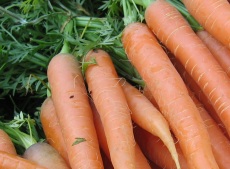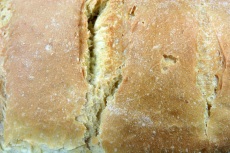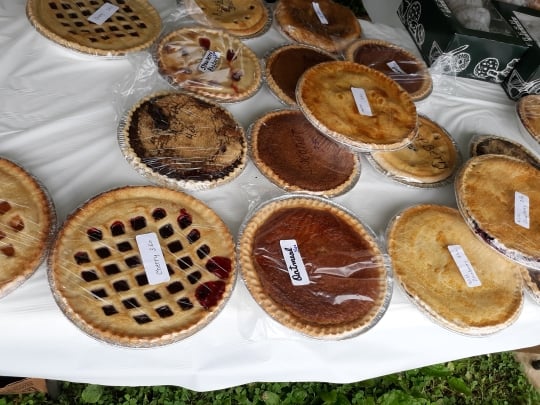Amish Food: What do Amish eat?
Amish consume a varied diet, including homegrown and store-bought foods
 Amish have a reputation for good food. Numerous tourist restaurants feature “Pennyslvania Dutch” and “Amish-style” cooking. Amish food typically is very filling, and not low-fat.
Amish have a reputation for good food. Numerous tourist restaurants feature “Pennyslvania Dutch” and “Amish-style” cooking. Amish food typically is very filling, and not low-fat.
In addition to home-grown and homemade foods, many Amish buy some pre-packaged foods in stores, and some may eat out in restaurants, sometimes as a treat, or more frequently if one’s occupation requires travel (as in the case of builders or market stand owners).
Home-grown foods
Nearly all Amish homes have a sizable garden, tended by the woman of the home with help from her children. Sweet corn, celery, beets, carrots, potatoes, tomatoes, peas, and a wide variety of other vegetables are grown in the typical Amish garden. Amish may have fruit trees or grapevines on their property as well. Amish eat a lot of fresh foods in the growing and harvest months, and can large quantities of fruits and vegetables for the winter.

Amish also may raise their own livestock. Many Amish have laying hens which produce a steady stream of eggs. Chickens may be slaughtered for meat. Other Amish may raise pigs for the same purposes.
Depending on the level of technology permitted in a congregation, Amish may freeze large quantities of food, particularly meat. Some Amish hunt, and deer and other animals killed while hunting serve as food sources for the family as well.
Amish dairies provide farm families a steady supply of milk and dairy goods, though even families without a dairy may have a “family cow”. Amish often drink milk raw, and claim that it has health benefits, though selling raw milk to the public has been controversial in some states.
Cooking
There are a huge amount of Amish cookbooks on the market, many produced with contributions of Amish women. Amish make a wide variety of Pennsylvania-Dutch style foods, including pot pies, butter noodles, chicken corn soup, varieties of bologna, chow-chow (a pickled relish made from a variety of vegetables), chipped beef gravy, beets, apple butter, and other hearty foods based on staples such as pork, potatoes, and cabbage.
Scrapple, a meat product made from animal parts (typically pork), corn meal and flour, is also popular, particularly for breakfast.
Non-traditional foods are popular as well. Pizza and Mexican-style foods are common, as are staples such as hamburgers and hot dogs. Some Amish enjoy cooking out over a grill or fire, and more progressive Amish homes may feature modern grills.
The kitchen is traditionally the domain of the Amish female, and Amish men do minimal preparation of food.
Baking

Amish bake a wide variety of goods, including desserts such as pies, cookies, cakes, and also breads. Shoofly pie is popular particularly in Lancaster County. Snitz pie, made from dried apples, is also featured at after-church meals in this settlement. Shoofly and snitz pies are not commonly seen in Midwestern Amish settlements. Rhubarb, blueberry, peach, and pecan are other common varieties of pie.
Whoopie pies, comprising two slabs of chocolate cake stuffed with sweet crème, are popular as well, as are fry pies, a pocket of crust stuffed with pie filling. Some Amish operate bakeries which sell products to the public. Baking is a common occupation for Amish housewives.
Amish buy foods from the store
Despite eating a large amount of home-grown food, Amish purchase food in stores as well. Amish shop in a variety of places, including local dry goods and “bent-and-dent” bulk foods stores, as well as larger supermarkets such as Wal-Mart. Amish buy breakfast cereals, breads, meats and cheeses, and other pre-packaged products. Some Amish may drink sodas or have a fondness for junk food. Others are very health-conscious.
Amish diets may vary
Amish eating habits vary between individuals and even groups. Most Amish, even those who do not farm, eat large amounts of dairy products. But Amish diets may vary by community and affiliation. Hurst and McConnell note that the generally lower income of Swartzentruber Amish often results in poorer nutrition.
Amish typically are not vegetarian or vegan, and eat meats such as pork, chicken, and beef. Some meals may lack meat or feature cheese or eggs as primary sources of protein.
Consumption of alcohol and other beverages

Amish alcohol consumption may vary by community and affiliation. Some communities have a higher incidence of alcohol use, while in others it may be nearly non-existent.
Some Amish make their own wine, which they may drink in moderation for health purposes. Wine may be made from fruits such as blackberries, raspberries, grapes, and even beets. New Order Amish, however, prohibit alcohol use among members and youth.
Amish drink wine at the twice-yearly communion services. Some may have a glass of wine at weddings.
As for other beverages, Amish typically drink water, milk, garden tea, and sometimes juices or sodas with meals. Coffee is popular among Amish, and is typically taken unsweetened and without cream.
The Sunday church meal
Amish eat a special meal after church service on Sunday. Foods are relatively light and simple, and typically consist of bread, cheese or cheese spread, cold cuts, sliced pickles, pickled beets, pretzels, and a special peanut butter spread, sweetened with molasses. Black coffee and water are served.
Sunday meals may vary as well. As mentioned above, Snitz pie is common in the Lancaster settlement, while Amish in the Midwest may serve different varieties of pie, or cookies, brownies and baked goods. Swartzentruber Amish traditionally eat bean soup from a common bowl, accompanied by beets, pickles, and bread.
Amish eat in restaurants
The move away from the farm and into business and non-farm occupations has likely resulted in Amish eating more store-bought, pre-packaged foods, and also for an increase in eating in restaurants. Boyd and Wurthmann’s in Berlin, or Mrs. Yoder’s in Mount Hope are two restaurants in the Holmes County community frequented by Amish.

Amish construction workers may purchase breakfast sandwiches from a gas station or other venue on the way to the jobsite. A trip to McDonald’s or Burger King with children may be seen as an occasional treat. Just like other businesses in Amish areas, local restaurants accommodate their Amish clientele.
The McDonald’s in the Amish-settled area of Sugarcreek, Ohio, features buggy parking, as does the Pizza Hut in Lagrange, Indiana. Some Amish may criticize the practice of eating out as wasteful and symbolic of a more worldly lifestyle.
The Amish diet has changed
Amish continue to eat large amounts of fresh and low-processed foods, especially in comparison to the typical American diet. Amish appreciate good food, and Amish housewives spend much time and labor in preparing foods for the family.
However, Amish diets have changed with the shift away from agriculture. Hurst and McConnell note that one result of Amish eating out more due to changes in occupation has been “the introduction of more additives, preservatives, and processing into their foods” (Paradox, Hurst/McConnell, p233).
There’s one part of the Amish diet we only touched on – canning. You might enjoy our photos from an Amish housewife’s basement. With 9 children, she’s well stocked with all sorts of canned goods. Or, you might be wondering which are the best Amish restaurants. We’ve also had a lively discussion of the tastiest Amish desserts. Monster cookies, snitz pie, date pudding, sawdust pie, yum…
For further information, see:
An Amish Paradox: Diversity and Change in the World’s Largest Amish Community, Charles E. Hurst and David L. McConnell






I don’t see anything wrong with the Amish eating out in Restaurants……the food probably isn’t any worse than what they eat at home…since they do cook with LARD…..but I wonder do they also cook with vegetable,olive,canola oil, etc ?
They are not lazy people, so I suppose for all the bad eating they do, they work it off…..as they sure don’t sit and watch tv, play silly computer games,stay on cell phone…. etc….and they probably get enough sleep as they go to bed early…..so what if they go out and eat….it’s their priviledge…….I’m sure they don’t go out and eat every day like some of the Englischers do…….
There is nothing wrong with eating animal fat, in fact, prior to the mid 20th century, when the scientific/business/political machine disseminated the message that dietary saturated fat and cholesterol were the cause of cardiovascular disease, people ate animal fat and were healthy. It is only since “science” took over food production with the introduction of “heart healthy” poly-unsaturated fats (vegetable oils) and hydrogenated oils along with high-fructose corn syrup and artificial flavors, colors and preservatives that the health in this country has gone way down. The Amish eat very traditionally and are very healthy when doing so. Sad to see that many are succumbing to modern ways of eating in America because it brings with it diseases of lifestyle, namely, heart disease, diabetes, stroke, and cancer to name a few.
Ann Gunn, M.S. Holistic Nutrition
I was raised in Pittsburgh and as you can see, married a man of German descent. A lot of my mother’s cooking was Pennsylvania German and a couple things I still make that I wonder if they are Pa. Dutch or just German. Pickled beets and eggs is one. I make a tart version, but have discovered some Amish make a sweet version. I don’t know whch, if either is a traditional Pa Dutch dish. And German potato salad, which we make hot with a bacon dripping-vinegar dressing. And scrapple. Mom made it with pork and beef scraps and lots of veggies, mostly carrots and on in. Loved it with maple syrup for breakfast!
I believe that the PA Dutch cooking we are all so interested in is more a tradition of farming and spending all day cooking than directed by rules.
food and area
my fathers family comes from clear field area iam look ing for a cook book from that area miss the food
the food IS worse than what they eat at home
Additives like Citric Acid (MSG hidden) Xanthum Gum
are poison.
Our food is terrible and poisonous.
Now the Amish will start having the same health problems most Americans do.
So, there IS something wrong with them eating our detestable food. They have every right to, but they are being lied to just like you.
Funny food discussion.
My suggestion: Let the Amish eat what they want.
They have so many restrictions so they deserve the freedom to choose their food themselves.
I was seraching for information about the Amish religion.
Now I found food religion.
Anyway, I don’t mind, I am vegetarian.
i love this response
“Let the Amish eat what they want”? Well, yeah… I just can’t believe people are wondering what Amish people eat and offering suggestions. Yes, please do let us eat what we want! I promise to let you do the same. 🙂
That’s the way to do it Mark…..eat what you want……that’s what I do 🙂
We went to an Amish place yesterday, they are the hardest working people I know…..I love going to an Amish bakery…..everything looks so good….love the fried pies…..they make a wonderful sandwich too, for $2.50 , looks like they put quarter lb. of meat and cheese on it….we always get one when we go there….
I see them shopping at Walmart all the time, and they don’t buy a lot of junk food either….basically large bags of sugar, flour, cornmeal, and things they don’t grow….. I would say they live a hard life…..I don’t think I would want to live like they do…..but they are probably a lot more healthier than the normal person…..as they don’t sit on the computer all day…..like some people I know 🙂 or watch tv……they work all day and when dark comes, they are tired and ready for bed…..I bet they don’t have a problem sleeping lol……I always say more power to them and leave them alone…….. you can learn things from them…..being lazy is not one of them…..we saw a little boy about 7 yrs. old hauling trash in a wheelbarrow to the large trash receptacle they use at the store…..so they do train them young……and that is a good thing…… my youngest granddaughter is 12 and she said grandma I would love to visit them and see how they live….and I said me too :)bet we could learn a thing or two from them…..
Well said, Kentucky Lady. 🙂 Now I’ll tell you what my lunch today was — leftover Chinese Take-out from last evening, homemade salad, cheese & pickles (cheese bought from Troyers Store, pickles canned at home) and a fry-pie. Delicious!
Actually, lard isn’t really that bad for you. It’s not a trans fat or hydrogenated oil. I don’t know why lard gets such a bad rap…perhaps from the Crisco empire 😉
There is a Chinese buffet not far from Union Station here in Chicago that is hugely popular with the Amish. I feel like when I go in there I’m the odd duck out!
What do the Amish eat
Exactly my point lard is not that bad for you.
I have freash pork fat in my freezer to melt down for lard real good
Lard is a natural by-product of animal fat and therefore used in moderation is much better for you in the long run. Also, butter they are now finding, in moderation is better than margarine.
The more natural the food the healthier it is. A good general rule of thumb if you really want to “eat healthy” if you can produce it yourself, if it was available during biblical times,,, its probably a lot healthier for you. However, if it is laden with chemicals or has to be created or processed in a plant somewhere,,, its probably not all that healthy.
Just my thoughts,,,,,,
Eating of Pork
I would have thought the Amish might not eat pork, but then they do.
I am sure it is better than the pork in a supermarket, because supermarket pork comes from hogs in which the organs have been recycled into more hog feed. Toxic metals such as cadmium would be
in some level in Amish pork (from acid rain and soil with cadmium in it). But supermarket pork should have more cadmium.
The Levitical law forbid pork, and Jesus was never known to eat pork,
else Jewish sects against him would have used it against him. Though Jesus ate with sinners, he did not eat pork. Rather he ate
fish and lamb generally. So, I would have expected Amish to raise sheep and chickens as did Jews in the time of Jesus. Also, the Jews sacrificed cows (as noted in the Exodus). But eating pork was not allowed.
If it were up to me, I would not use sewage sludge on soil, as it
contains heavy metals. I assume Amish do not do this. I also assume that they do not process pork by-products such as kidneys and livers into a food for hogs. This is a way to concentrate heavy metals in pork (using sewage and recycling by-products heavy in trace metals like cadmium).
I realize the Amish don’t want to be a part of the wicked world, but if they are getting acid rain, they cannot be safe from pollution. So, I think it would be a wise policy not to eat worldly pork and to stick with home raised pork without defilement from the world. Even that may not be good – sheep are better.
Pork consumption
The Amish are not Jewish in any way. They broke off of the Mennonites, a faith founded by Menno Simons in Europe around the time of Reformation.
The Law of Levitcus declared eating pork as wrong. However, in the New Testament, an apostle had a dream in which he was told to eat, and there was pork present. He refused, and this word was given to him.. “it is not what one puts in ones mouth that makes him unlcean, rather, it is what comes out of one’s mouth that makes him unclean, because what comes out of mans mouth is what is in his heart.” The apostle was also admonished about calling anything that God had created, unclean.
Wrong context
The vision that Peter had about the sheet unclean animals had nothing to do with God telling people to eat unclean foods. If you continue reading the story you will see that Peter gives the interpretation of the vision: not to call any MAN common or unclean, simply because they are Gentiles and not Jews. The vision was about man, not foods to eat, else they would not have reinforced kosher laws in Acts 15.
I agree Erik
I totally agree with your views on unclean foods.
I got mixed up on the reply option.
...?
Not sure if you meant this for me, or someone else, but for the record I don’t remember ever expressing any views on unclean foods 🙂 Maybe another commenter here?
Scrapple
Recently, a post about scrapple on the Pennsylvania Dutch At-Home Companion blog generated a lot of interest. This post contributes another primary source on scrapple, from Henry R. Bergey of Franconia Township, writing circa 1925.
Henry Ruth Bergey (1843-1925) was a farmer in ”Bergey Valley” along the Indian Creek in Franconia. This is the last entry in a manuscript notebook begun in 1924 when he was 80 years old. You can read more about Henry and his notebook in this post from January 2019: https://mhep.org/a-window-on-franconia-mennonite-character/. His writings are a valuable example of how Pennsylvania Dutch folks recorded their spoken English thought onto paper.
This transcription was first published in the MHEP Newsletter in January 1988.
On This Page you will Find how to Prepare a Good and also a Clean and helsy Scrapel with a Good tast and not mixed with all kinds of Stuff that a Person would hardly Eat them when they would know how they Prepare his Scrapel. it came to my Ears that Some People Prepare his Scrapel on a very comen Stile: to Sell to his Custimers: that lacketh my abedied for Scrapel any moor.
I was always a lover of Scrapel, Especial now when my Teeth getten Dull, and Four Score years Old. then my thought Came on Isaac when he geten Old he calleth his Elder Son, and told him to go out in the Field and Search for wilbert [Wildbret = venison] to make him a Saveour [savory] meat which he loveth then it came in my mind, could we not also make a Savour meat of Chicken in Stead [of] Wilbert which I love.
So we killed a Fat chicken and Boiled it, then Grinded them and my wife Mixt Corn and Bucked [buckweat] meal, and Coucked them for an half Our. and you wer Surprised when you would taste them: and not all that we know what we Eating. Therefore Ill Recommended Chicken Scrapel For Old and Young People who Search to have there Eatables Clean. We Received 14 lbs. Scrapel of one Chicken at 9 cts. per [lb.?]
I will give you a Description of my Saveour Mete which I loveth in the Presend time, when I am Four Score yours Old. Ill Generly tock two Slise of Bread and Smeard them well with Butter, and Put a TeaSpone full of Shuger on top, then Ill Pour a little hot water on top to Soke it then I add about 1/2 of a lb chick Scrapel and mix them together, and also Sometimes Pour a little Boiled Oat meal upon it and mixed with a little milk that would make a Saveour meat (not a Rich meal) which I loveth. and I would find no falt when I would recieved it three times a Day.
Because I have learn that a man Eateth For to live, and not live For to Eat. Espesial ought to know what to Eat that may Be Good for there complain[t]. Ill often heart People Say, no I Daunt want to have Every meal a like I want a Chang. When they Even knoweth what is good For ther Complain[t] But they wan[t] to Pleas his Mouth and careth more to Pleas There mouth then they do for there Body. But that is nothing new. We find when the Lord Fed the childrens of Israel in the former world with mana 40 years they also comenct to mer[mur] they want to have a cange they want meat. We find the lord giveth them meat So they Eat quailes that the Flesh came out there Nusetrills (Read the 11 chapter 4 Book of Moses). So it may Be Posable that the People have not Bin Fead well when they Get what they Desired and that is often the troubel in the Present time.
Eating pork?
I realize this is an Amish tradition handed down but how is it justified since God has declared such animals unclean and we should not eat them. This commandment was never done away with as most Christian denominations teach. In fact all of God’s Commandments are for ALL generations until heaven and earth pass away.
Ten commandments
I think God narrowed it down to the ten commandments. There are many suggestions in the bible people do not adhere to. Frankly, does a sheep hurt less when it is slaughtered than a pig does? God originally told us to eat herbs, not meat, but it changed.
Potatoes and Health
The Amish raise potatoes. I assume they have always raised potatoes in America. I assume they know about toxic alkaloids in green potatoes.
As for me, I don’t eat potatoes. The glycemic index is high, and I cannot work it off like the Amish. It tends to make me fat.
Alkaloids are toxic and can be developed in potatoes by roasting
and french frying. So, I hope Amish only eat boiled potatoes in
moderation (not green ones). But, I note that potatoes can take
up cadmium from soil, especially where there is acid rain. Phosphate fertilizers contain trace levels of cadmium, so Amish should not buy them (but use natural fertilizers). So, I think that Amish have good potatoes probably and should forget about
McDonalds french fries.
I'm surprised the Amish aren't vegetarian
I have food allergies and an upcomming business trip to an Amish area with company dinner at an Amish restaurant and realized there is nothing I can eat on the menu. I am vegetarian w/allergies to potatoes,wheat,eggs,alcohol-I have no problem w/rice,spice,msg,tofu,caffene,and most stuff in Asian,Indian,and African restaurants but have heart and breathing issues w/lard,seafood,wheat,potato-you know. I want to know if they would be offended if I asked for vegetables and rice w/no animal products or if they are normally vegan.By the way,I am Indian/Ethiopian/Mid East Jew and other Mid Eastern Jews have the same food allergies and are mostly vegetarian so I think Jesus would’ve at least avoided the fish especially in the hot climate-maybe a spicy falafel.They didn’t eat meat until moving to colder Europe w/mixture to locals who could eat anything without food allergies.
Amish vegan meal
Ms. Fox I doubt if you’ll offend anyone with your request, especially if you explain your allergies. Amish tend to be sensitive to medical issues. You might want to emphasize no butter, eggs, etc however as the difference between ‘vegetarian’ and ‘vegan’ might not be immediately clear.
By the way I sympathize with your food allergies, and to be honest did not know that potato allergies even existed. It sounds like as you describe it is hereditary to certain groups.
Allergies
The reason you’re allergic to everything is because you avoid everything. You’re immune system can’t protect you if you don’t give it the material it needs.
The first thing you need to do is drink lots of water and use adequate salt. Dehydration is the underlying cause of allergies.
other foods
Do they eat legumes (beans and lentils)? Tofu and soymilk?
Also, how much exercise do they get a day?
What would u estimate their macronutrient breakdown be (% of carbs, protein, fats) and calories? It would be interesting to see how this all compares to the dietary recommendations produced by the govt vs how the amish eat…and who comes out healthier
Amish diet and nutrition
Bee, the short answers would be beans, yes, tofu and soy products, probably not much.
Exercise–there has been a study or two showing Amish move around a lot more than the average non-Amish. There are some overweight and even obese Amish however. On balance I’d say the average Amish person gets more exercise than the average American.
I can’t give a micronutrient breakdown, but I’d guess compared to norms it’s a diet fairly high in carbs and fats. Typical Amish fare is not the healthiest food, or at least not food for weight watchers 🙂
Im actually surprised that they dont eat as healthy as i thought. Especially since they grow and make their own food, i wouldve assumed it wouldnt be as high in fats/breads/carbs.
What do they do for fruits?
Do u think that the amount of overweight Amish is on-par with typical Americans (isnt it like 1/3 of the population or more is overweight)?
Do Amish tend to have less, more, or similar health issues as non-Amish? What are the most common health problems?
There are a lot of veggies and fruits, canned and fresh, as well.
It’s a pretty physical culture with manual labor jobs common, so I think the Amish waistline can weather the pies and casseroles a little better than most of us.
On weight I believe the % of overweight Amish is probably a good bit lower than the American average (there have been a couple of studies in this area if I’m not mistaken).
Help please!
Does anyone remember where the “favorite recipes” are on this site?
I volunteered a dessert for luncheon tomorrow, and I’m trying to find the Pumpkin Yummy Cake recipe I got off here last year-
Anyone remember where those recipes are?
Thank you in advance,
Blessings to/on ya’all today,
Valerie
Pumpkin Pie Recipe
Hi Valerie, I’m not sure if this is the same, but the only pumpkin recipe I could find was for pie–from this post 2 years ago, on Sherry Gore’s Taste of Pinecraft cookbook: https://amishamerica.com/taste-of-pinecraft-winners-sample-recipes-and-stories/
Fluffy Pumpkin Pie
24 lg. marshmallows
1 (15 oz.) can pumpkin
1/2 tsp. cinnamon
1/2 tsp. allspice
1/4 tsp. salt
1 cont. frozen whipped topping
In small saucepan melt marshmallows over low heat. Remove from
heat and stir in pumpkin and spices. Cool, then add 3/4 cont. whipped
topping. Refrigerate at least 4 hrs. Decorate with rest of topping.
Sadie Hochstetler *Pinecraft, FL
Funny you should ask about that today–we’ve got a special recipes section with 300+ recipes in the works, which should make things easier to find 🙂
Thanks Erik!
That looks “yummy” too,
It’s not the one I was looking for, this is an actual sheet cake,
someone on here posted the recipe last Fall-I made it, everyone loved it too-
That pie, wow-RICH-jah? Have to try that one, but I need to feed a bigger group so the cake was nice size but I’m looking forward to that section coming.
Bless you!
Pumpkin Yummy Cake
Valerie I checked again, and I think I found it. Debbie Welsh posted this last October:
Pumpkin Yummy Cake:
32 oz canned pumpkin 1 cup brown sugar 2 tsp cinnamon
1/2 tsp ginger 1/4 tsp nutmeg 3 eggs
1 13 oz can evaporated milk 1 box yellow cake mix
3/4 cup butter or margarine
Combine pumpkin, sugar, and spices. Beat in eggs and milk until smooth. Pour into 13x9x2″ greased baking pan. Sprikle dry cake mix over pumpkin mixture. Drizzle melted butter over cake mix ( can add nuts before baking ). Bake at 350 for 55-60 mins. Enjoy!
https://amishamerica.com/marketing-amish-recipes/comment-page-1/#comment-22408
Thank You Erik!!!
Bless your heart! (oh my, my grandma used to always say that :))
How did you do that? I tried your search field several times, you are a dear for finding that for me!
Have a blessed day, by the way, that recipe is easy and you could make it yourself & impress Izabella (sp?)
Thanks Valerie, the search field unfortunately doesn’t scan content from the comments section, just content from the posts themselves. Someone else noted this to me, and now you’ve reminded me about it. Will try to get a fix soon.
You’re right, it looks easy enough, and there are enough pumpkins about now, so maybe that’s an idea 🙂
Bringing This Recipe Back Out!
It’s that time of the year again, and Erik helped me last year find this recipe posted in 2012. It is so “yummy” and I’m bringing it once again to a home group (this time)
Just wanted to bring it back so people will see it and better yet, make it!
Excellent, Valerie, I wish there were a way to share the actual desserts across social media, but I don’t think we’re there yet 🙂
Recipes
If you type RECIPES into the search bar on the top right hand corner of the page they are all there. Now I’m hungry.
Food
I am going to Lancaster, PA this Spring this is not my first time there. But I am tired of reading signs that the word “Amish” is on their store front when they are not “Amish”. I want to purchase Amish food and desserts plus their homemade products, I am afraid I am not buying “Real” Amish products. Where would I go for thier farmers markets, etc? Where would I go to eat their food? I wanted to stay at an “Amish” B&B this time. I respect their ways and I do not judge their food. No is a perfect cook.
Amish food
I too get a little tired of the word “Amish” being used to sell things that obviously are not Amish. As for Amish food.. I was raised Mennonite and a of out traditional food is the same as the Amish… as the Amish broke off of the Mennonites years and years ago. However, when I am in Amish country (about 10 miles from where I live, is a small Amish community) I stop at roadside stands. When I am pulling into a stand that sits squarely in front of an Amish farmhouse with Amish children playing in the yard and Amish young people manning the stand, I am pretty much guaranteed that the food I will be purchasing, is indeed, Amish.
Cookbook with a globe on it
My aunt had cookbook with a globe printed on it, but I can’t remember whether or not it was Amish or Mennonite. I’ve tried to look for anything even remotely close that description and found nothing. It’s very possible that it was Mennonite because there were different recipes from different countries around the world in it. Anybody with any suggestions on what the title is would be greatly appreciated. I also think it might have been a hardcover cookbook.
Cookbook
I have the “More With Less” cookbook, which I believe is Mennonite.
Fats aren't bad!!
The Amish eat very healthy!!! With the exception of refined sugar.
I highly recommend y’all look into “nourishing traditions”. American’s have been lied to and as a result our health and the health of our children is in grave danger. We have so much disease and cancer and food allergies thanks to our walking away from traditional food preparation. Every nerve in our bodies (including our brain) is surrounded by fat, it is an essential part of our diet!!!
Recipes
Amish food is fresh and tasty. There are many recipe books out there with great recipes. I know an Amish family personally and they created a recipe book that contains over 400 recipes. I baked some chocolate chip chews using one of the recipes and it was delicious. The book also has quilt patterns and the meaning behind the quilt patterns. I really recommend this recipe book. This family is also grandparents of some of the girls that were killed in the Amish school shooting in 2006 and they have included a section as a memorial. Purchase a copy at http://www.amishselections.com/country-lane-quilts-and-family-cooking-amish-recipe-book/
yup yup you’s right fresh un contaminated food thats fed fresh uncontaminated food.
how awful it would be to have to eat out some resteraunt being any different just the thought is cringe.
Finally found the cookbook!
I finally found the cookbook after what seemed an eternity(just joking!)of searching for it. It’s called Mary Yoder’s East West Cooking.It’s by a Mennonite woman.She sells them on the Internet and her store in Ohio.There are different cooking styles from different places around the world in it.I still can’t believe it’s been 7 years since that happened.I’d say it took a lot of courage to forgive that man and his family for what he did to those families and that community.Good for them to be able to do it,most people wouldn’t be able to forgive like that or that fast either.
Hi Erik,
You mentioned in one of the comments after you posted the pumpkin pie recipe, that you had a special recipe section with 300 plus in the works, did you ever post that and if you did, where can I find it or can you email me a copy ? Thanks Erik
Amish recipes
If you all don’t mind that I’m not Erik, at this time, Kentucky Lady, you can either scroll to the very end of this page and click on “Amish Recipes” in the banner area or go directly to
https://amishamerica.com/amish-recipes/
Thank you Linda–I certainly don’t mind 🙂
Common bowl
“Swartzentruber Amish traditionally eat bean soup from a common bowl, accompanied by beets, pickles, and bread.”
Eating out of the same bowl is very Central European. We wouldn’t share soup in Austria – probably because of how messy it would get – but we do eat salad from the same bowl.
Goats
Do the Amish eat goat meat?